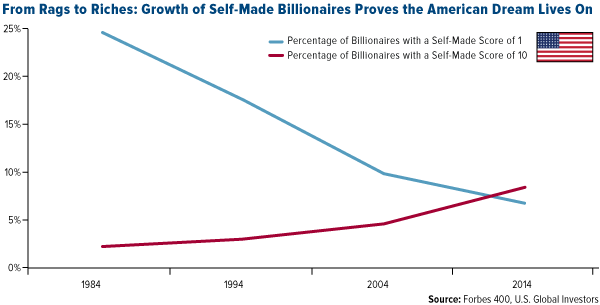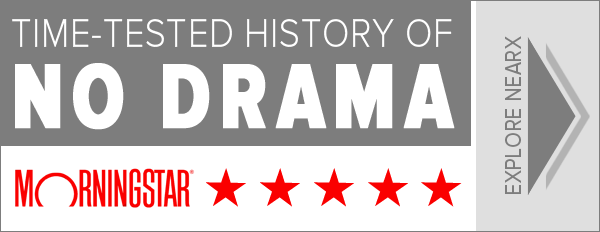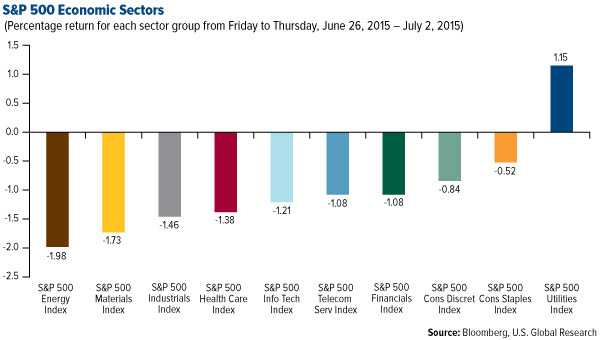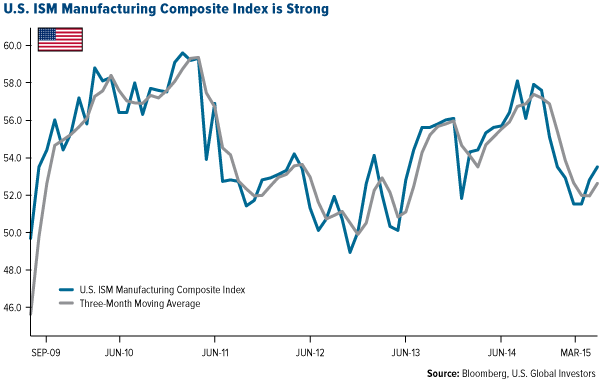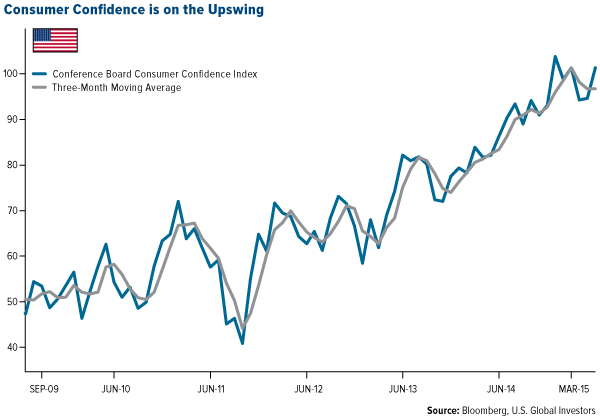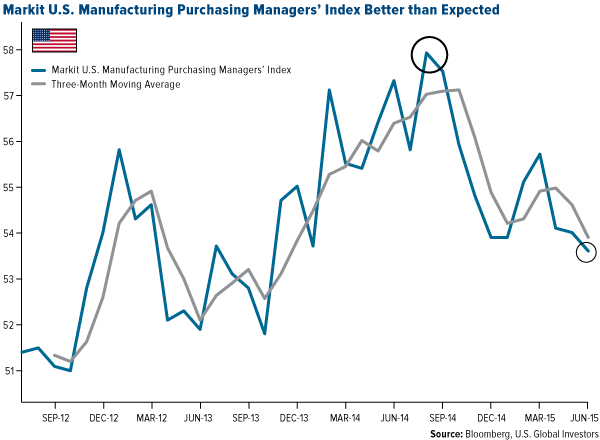By Tabinda Hussain. Originally published at ValueWalk.

Home of the Free
Home of the Free, Land of the Entrepreneur
By Frank Holmes
CEO and Chief Investment Officer
U.S. Global Investors

Home of the Free |
At 16, Jan Koum immigrated to the U.S. from his native Ukraine, then still under communist control. He and his single mother rented a small two-bedroom apartment on government assistance and relied on food stamps. Even though he didn’t own a computer at the time, Koum devoured computer networking manuals and became proficient at hacking, a skill that helped him land a job at Yahoo! Inc. (NASDAQ:YHOO)! in 1997.
But after nine years at the Internet company, Koum grew restless. He had other ideas and ambitions. Within a year of leaving Yahoo!, he developed a new instant messaging app for smartphones that he named WhatsApp. Its popularity took off, and Koum watched the valuation of his startup soar from $250,000 in 2009 to $1.5 billion in July 2013.
The following year—only five years after its launch—WhatsApp was acquired by social media titan Facebook Inc (NASDAQ:FB) for $16 billion plus $3 billion for the company’s founders. In a symbolic gesture, Koum signed the paperwork at the building that had once served as the welfare office where he received his food stamps. With the stroke of a pen, he became $6.8 billion richer. Today, WhatsApp is the top messaging app in the world, with 800 million monthly users, and Koum is number 208 on the Forbes 400 list of wealthiest Americans.

Home of the Free |
Koum’s story might sound like a plotline from the mind of Horatio Alger, the nineteenth-century American novelist whose works dramatize the rise of an impoverished young man to financial prominence. But American history is replete with such stories, starting with that of Benjamin Franklin. One of the Founders of the United States, Franklin helped guarantee that this country would be a place where people can freely pursue their dreams, innovate and capitalize on their achievements.
Much has changed since Franklin signed the Declaration of Independence nearly 240 years ago, but America still stands as a land of opportunity for U.S.-born citizens and immigrants alike.
Where else but in America can a startup such as Uber be valued at $50 billion, higher than 80 percent of the companies in the S&P 500 Index, only six years after its founding? Where else but in America can someone reach billionaire status by inventing a new type of hosiery, as Sara Blakely did with Spanx? Before her now-ubiquitous undergarments were worn by women—and now men—all over the globe, Blakely was so broke that she had to write her own patent without the help of an attorney.
As I pointed out in a Frank Talk early last month, nearly 70 percent of billionaires who show up in the Forbes 400 list are self-made. In fact, the percentage of those who have a self-made score of 10, meaning they created their wealth from nothing (think Jan Koum, Oprah Winfrey and George Soros), now exceeds the percentage of those with a score of 1, indicating they inherited every cent (Laurene Powell Jobs, widow of Apple Inc. (NASDAQ:AAPL)-founder Steve Jobs).
Regarding Apple, the tech giant represents just one of numerous American companies that were founded by either an immigrant or the child of an immigrant (Jobs’ biological father, still living, is Syrian). Recent examples include Sergey Brin, co-founder of Google Inc (NASDAQ:GOOG) (NASDAQ:GOOGL), who emigrated from the U.S.S.R.; Elon Musk, CEO of Tesla Motors Inc (NASDAQ:TSLA), originally from South Africa; and Yahoo! founder Jerry Yang, a Taiwanese émigré. According to the entrepreneurial research firm Kauffman Foundation, a quarter of all technology and engineering companies created in the U.S. between 2006 and 2010 were founded by foreign-born entrepreneurs. Amazingly, more than 40 percent of Fortune 500 companies were at least co-founded by immigrants or their children: AT&T, Budweiser, General Electric Company (NYSE:GE) and International Business Machines Corp. (NYSE:IBM), among many more.
It’s doubtful that Jan Koum would have found the same level of success had he and his mother stayed in Ukraine. Fortunately for him, as well as the millions who regularly enjoy and benefit from his innovative service, the U.S. welcomed him in and allowed his talents to flourish.
I want to wish everyone a safe and happy Fourth of July, and to my friends and family in Canada, a happy Canada Day!

Home of the Free
Index Summary
- Major market indices finished down this week. The Dow Jones Industrial Average fell 1.21 percent. The S&P 500 Stock Index fell 1.18 percent, while the Nasdaq Composite fell 1.40 percent. The Russell 2000 small capitalization index fell 2.46 percent this week.
- The Hang Seng Composite fell 2.02 percent this week, while Taiwan fell 0.92 percent. The KOSPI rose 0.82 percent.
- The 10-year Treasury bond yield fell 9 basis points to 2.38 percent.
Domestic Equity Market
Strengths
- The U.S. ISM Manufacturing Index rose higher than expected for the month of June, a much needed positive sign for the industrial sector. The reading came in at 53.5, compared to an expected 53.2 and a reading of 52.8 for the prior month.
- The Conference Board’s consumer confidence index jumped up for the month of June, surpassing analysts’ expectations. The reading came in at 101.4, compared to an expected 97.4 and a reading of 95.4 for the prior month.
- Utilities was the best performing sector in the S&P 500 this week due to the crisis unfolding in Greece and the subsequent decline in U.S. bond yields. The S&P 500 Utilities Index rose 1.14 percent this week.
Weaknesses
- Energy was the worst performing sector in the S&P 500 this week as WTI crude prices slumped. The S&P 500 Energy Index fell 1.98 percent this week.
- Although the unemployment rate in the U.S. declined, the increase in nonfarm payrolls was weaker than expected.
- Turmoil in Europe continues to create a significant amount of uncertainty in global markets.
Opportunities
- The final Markit U.S. Manufacturing purchasing managers’ index (PMI) for the month of June came in at 53.6, higher than expected and well above the critical 50 mark.
- The Markit U.S. Services PMI will be released next week and is expected to increase.
- The Bloomberg Consumer Comfort Index will be released next week. Given the positive momentum behind many consumer-based indicators, the expectation and hope is for a positive reading from this one as well.
Threats
- The economic confidence index in the eurozone fell from 103.8 to 103.5 for the month of June.
- The U.S. trade balance results for the month of May will be released next week. The trade deficit is set to widen, most likely as a result of the strong U.S. dollar.
- The turmoil in Europe, although not a direct threat to the U.S. economy, could have negative repercussions for overall global growth.
The Economy and Bond Market
The uncertainty in Greece continued to weigh on global financial markets this week as the country edged closer to debt default and a possible eurozone exit. Much rests on the results of a public referendum this Sunday. Global stocks were mixed, with most major indices range-bound after a sharp drop on Monday. The yield on the U.S. 10-year Treasury note closed the week at 2.39 percent.
Strengths
- The National Association of Realtors’ index of U.S. pending home sales rose 0.9 percent to a seasonally adjusted 112.6, the highest level since April 2006. It is the latest sign the housing market has regained momentum after a slow start this year.
- The Institute for Supply Management (ISM) saw its index of national factory activity climb from 52.8 in May to 53.5 in June, the highest level since January.
- Increased by consumer sentiment on the condition of the labor market, the Conference Board’s consumer confidence index rose to 101.4 for the month of June.
Weaknesses
- The June employment report shows nonfarm payroll growth of 223,000, but with net revisions of -60,000 to the prior two months. The unemployment rate dropped to 5.3 percent from 5.5 percent in May, but for all the wrong reasons as household employment fell by 56,000 and the labor force participation rate
Sign up for ValueWalk’s free newsletter here.



